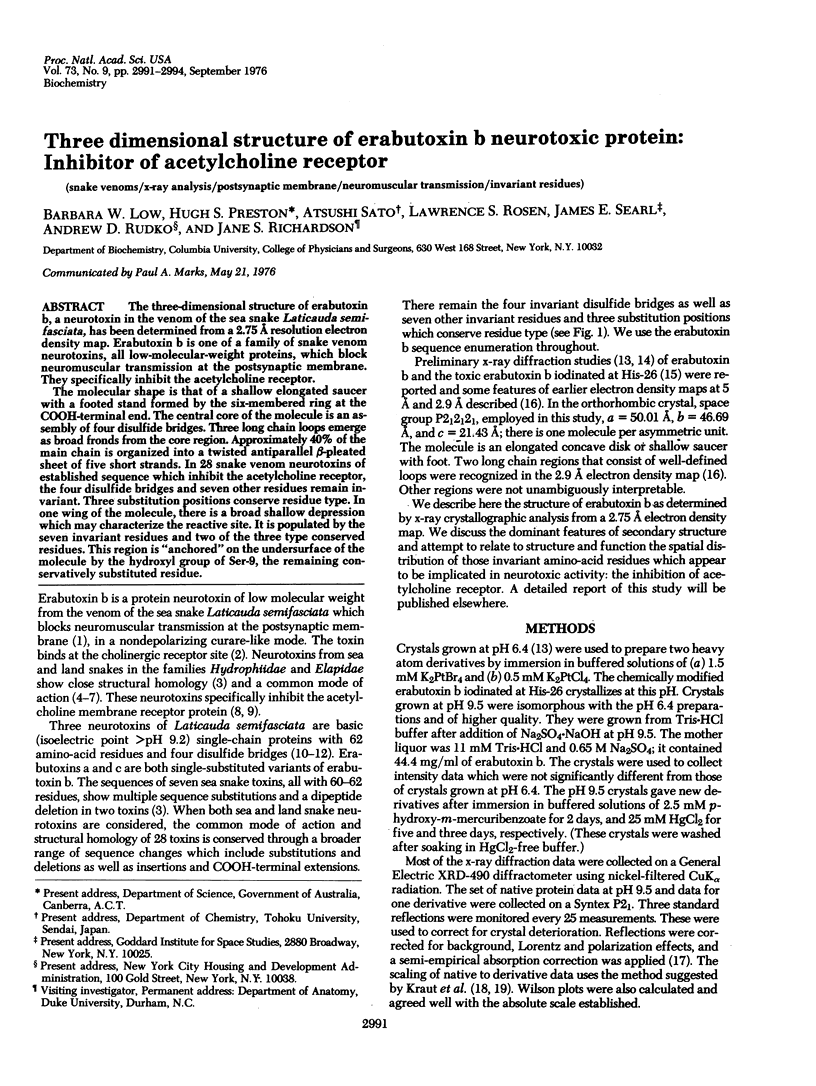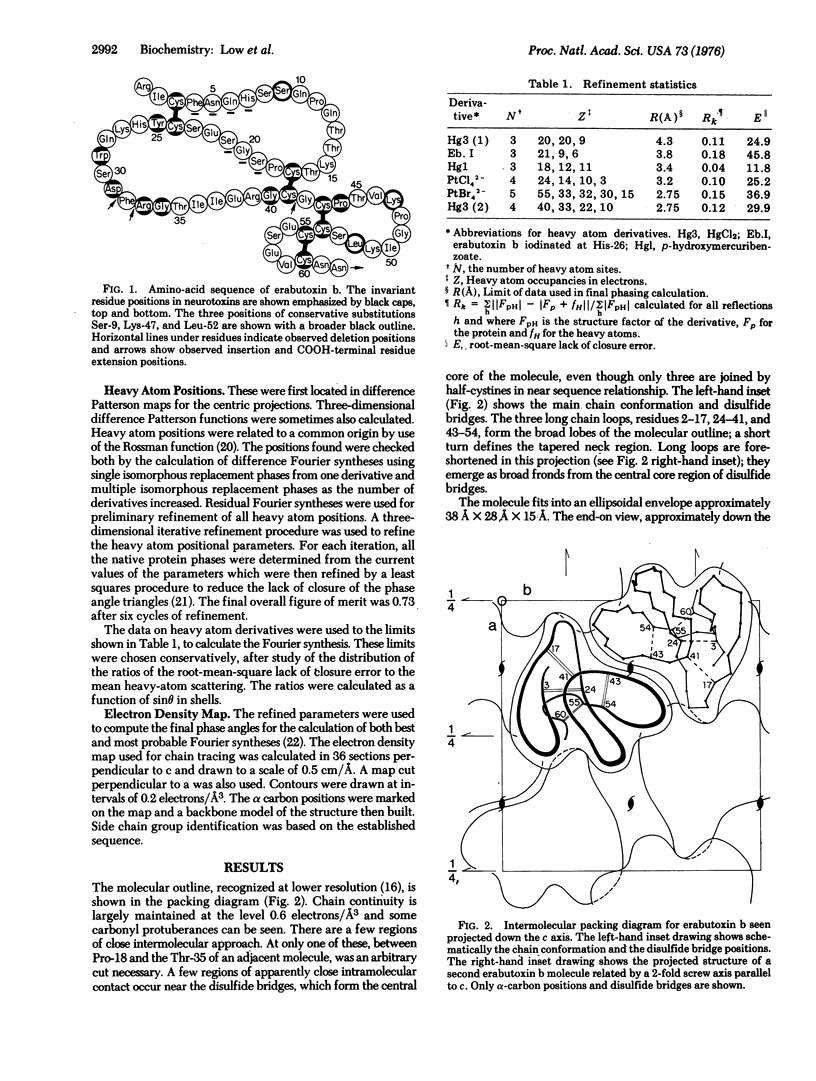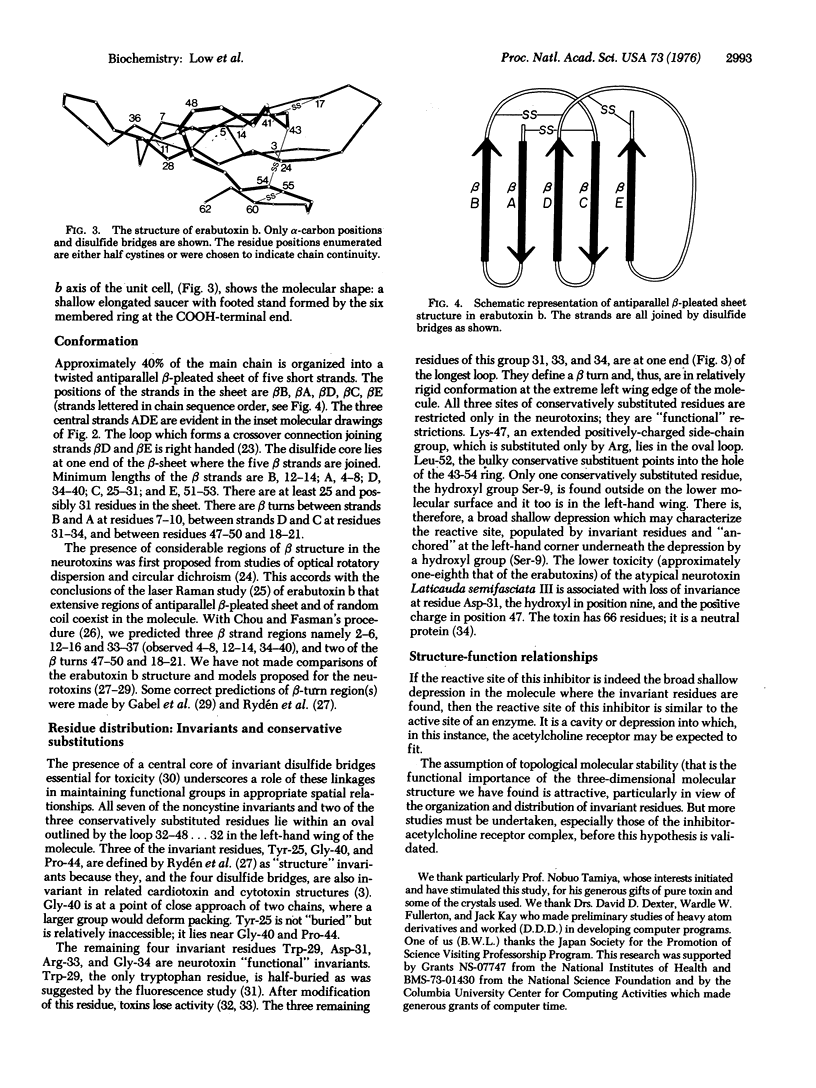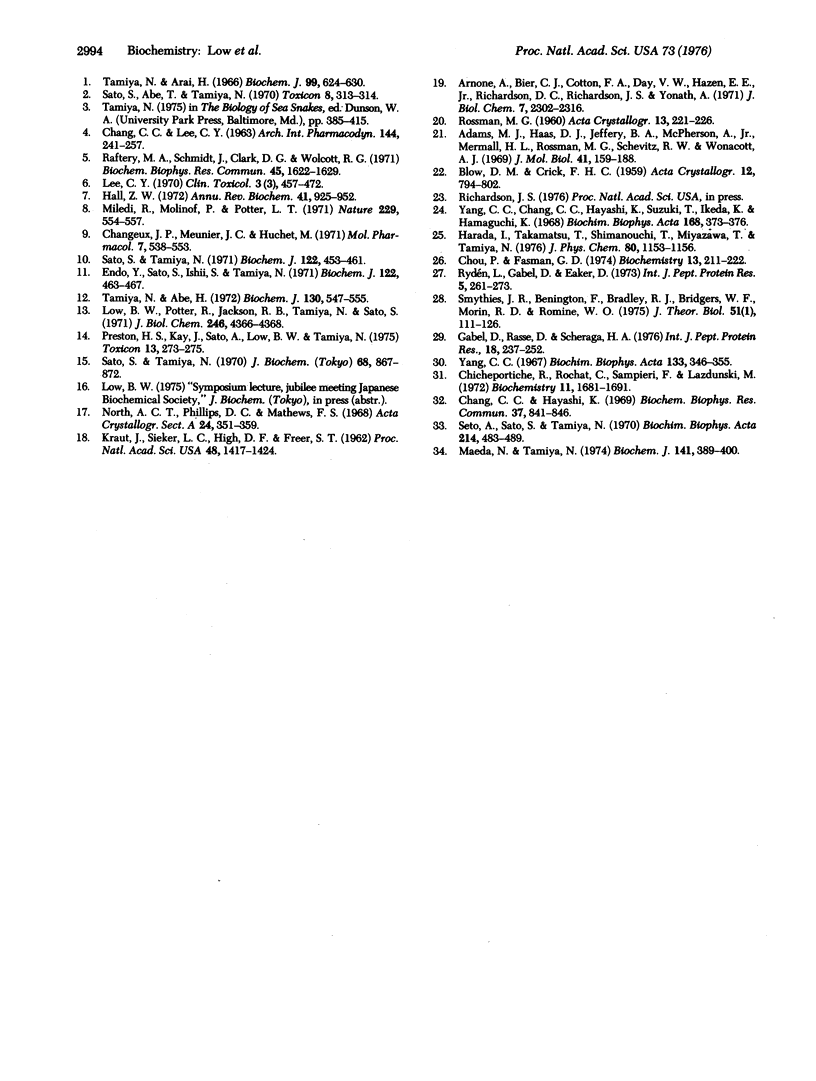Abstract
The three-dimensional structure of erabutoxin b, a neurotoxin in the venom of the sea snake Laticauda semifasciata, has been determined from a 2.75 A resolution electron density map. Erabutoxin b is one of a family of snake venom neurotoxins, all low-molecular-weight proteins, which block neuromuscular transmission at the postsynaptic membrane. They specifically inhibit the acetylcholine receptor. The molecular shape is that of a shallow elongated saucer with a footed stand formed by the six-membered ring at the COOH-terminal end. The central core of the molecule is an assembly of four disulfide bridges. Three long chain loops emerge as broad fronds from the core region. Approximately 40% of the main chain is organized into a twisted antiparallel beta-pleated sheet of five short strands. In 28 snake venom neurotoxins of established sequence which inhibit the acetylcholine receptor, the four disulfide bridges and seven other residues remain invariant. Three substitution positions conserve residue type. In one wing of the molecule, there is a broad shallow depression which may characterize the reactive site. It is populated by the sevent invariant residues and two of the three type conserved residues. This region is "anchored" on the undersurface of the molecule by the hydroxyl group of Ser-9, the remaining conservatively substituted residue.
Full text
PDF



Selected References
These references are in PubMed. This may not be the complete list of references from this article.
- Adams M. J., Haas D. J., Jeffery B. A., McPherson A., Jr, Mermall H. L., Rossmann M. G., Schevitz R. W., Wonacott A. J. Low resolution study of crystalline L-lactate dehydrogenase. J Mol Biol. 1969 Apr;41(2):159–188. doi: 10.1016/0022-2836(69)90383-0. [DOI] [PubMed] [Google Scholar]
- Arnone A., Bier C. J., Cotton F. A., Day V. W., Hazen E. E., Jr, Richardson D. C., Yonath A., Richardson J. S. A high resolution structure of an inhibitor complex of the extracellular nuclease of Staphylococcus aureus. I. Experimental procedures and chain tracing. J Biol Chem. 1971 Apr 10;246(7):2302–2316. [PubMed] [Google Scholar]
- CHANG C. C., LEE C. Y. ISOLATION OF NEUROTOXINS FROM THE VENOM OF BUNGARUS MULTICINCTUS AND THEIR MODES OF NEUROMUSCULAR BLOCKING ACTION. Arch Int Pharmacodyn Ther. 1963 Jul 1;144:241–257. [PubMed] [Google Scholar]
- Chang C. C., Hayashi K. Chemical modification of the tryptophan residue in cobratoxin. Biochem Biophys Res Commun. 1969 Nov 20;37(5):841–846. doi: 10.1016/0006-291x(69)90968-1. [DOI] [PubMed] [Google Scholar]
- Changeux J. P., Meunier J. C., Huchet M. Studies on the cholinergic receptor protein of Electrophorus electricus. I. An assay in vitro for the cholinergic receptor site and solubilization of the receptor protein from electric tissue. Mol Pharmacol. 1971 Sep;7(5):538–553. [PubMed] [Google Scholar]
- Chicheportiche R., Rochat C., Sampieri F., Lazdunski M. Structure-function relationships of neurotoxins isolated from Naja haje venom. Physiochemical properties and identification of the active site. Biochemistry. 1972 Apr 25;11(9):1681–1691. doi: 10.1021/bi00759a024. [DOI] [PubMed] [Google Scholar]
- Chou P. Y., Fasman G. D. Conformational parameters for amino acids in helical, beta-sheet, and random coil regions calculated from proteins. Biochemistry. 1974 Jan 15;13(2):211–222. doi: 10.1021/bi00699a001. [DOI] [PubMed] [Google Scholar]
- Endo Y., Sato S., Ishii S., Tamiya N. The disulphide bonds of erabutoxin a, a neurotoxic protein of a sea-snake (Laticauda semifasciata) venom. Biochem J. 1971 May;122(4):463–467. doi: 10.1042/bj1220463. [DOI] [PMC free article] [PubMed] [Google Scholar]
- Gabel D., Rasse D., Scheraga H. A. Search for low-energy conformations of a neurotoxic protein by means of predictive rules, tests for hard-sphere overlaps, and energy minimization. Int J Pept Protein Res. 1976;8(3):237–252. doi: 10.1111/j.1399-3011.1976.tb02500.x. [DOI] [PubMed] [Google Scholar]
- Hall Z. W. Release of neurotransmitters and their interaction with receptors. Annu Rev Biochem. 1972;41:925–952. doi: 10.1146/annurev.bi.41.070172.004425. [DOI] [PubMed] [Google Scholar]
- KRAUT J., SIEKER L. C., HIGH D. F., FREER S. T. Chymotrypsinogen: a three-dimensional fourier synthesis at 5 angstrom resolution. Proc Natl Acad Sci U S A. 1962 Aug;48:1417–1424. doi: 10.1073/pnas.48.8.1417. [DOI] [PMC free article] [PubMed] [Google Scholar]
- Low B. W., Potter R., Jackson R. B., Tamiya N., Sato S. X-ray crystallographic study of the erabutoxins and of a diiodo derivative. J Biol Chem. 1971 Jul 10;246(13):4366–4368. [PubMed] [Google Scholar]
- Maeda N., Tamiya N. The primary structure of the toxin Laticauda semifasciata III, a weak and reversibly acting neurotoxin from the venom of a sea snake, Laticauda semifasciata. Biochem J. 1974 Aug;141(2):389–400. doi: 10.1042/bj1410389. [DOI] [PMC free article] [PubMed] [Google Scholar]
- Miledi R., Molinoff P., Potter L. T. Isolation of the cholinergic receptor protein of Torpedo electric tissue. Nature. 1971 Feb 19;229(5286):554–557. doi: 10.1038/229554a0. [DOI] [PubMed] [Google Scholar]
- Preston H. S., Kay J., Sato A., Low B. W., Tamiya N. Crystalline erabutoxin c. Toxicon. 1975 Aug;13(4):273–275. doi: 10.1016/0041-0101(75)90133-6. [DOI] [PubMed] [Google Scholar]
- Raftery M. A., Schmidt J., Clark D. G., Wolcott R. G. Demonstration of a specific -bungarotoxin binding component in electrophorus electricus electroplax membranes. Biochem Biophys Res Commun. 1971 Dec 17;45(6):1622–1629. doi: 10.1016/0006-291x(71)90207-5. [DOI] [PubMed] [Google Scholar]
- Rydén L., Gabel D., Eaker D. A model of the three-dimensional structure of snake venom neurotoxins based on chemical evidence. Int J Pept Protein Res. 1973;5(4):261–273. doi: 10.1111/j.1399-3011.1973.tb03460.x. [DOI] [PubMed] [Google Scholar]
- Sato S., Abe T., Tamiya N. Binding of iodinated erabutoxin b, a sea snake toxin, to the endplates of the mouse diaphragm. Toxicon. 1970 Nov;8(4):313–314. doi: 10.1016/0041-0101(70)90010-3. [DOI] [PubMed] [Google Scholar]
- Sato S., Tamiya N. Iodination of erabutoxin b: diiodohistidine formation. J Biochem. 1970 Dec;68(6):867–872. doi: 10.1093/oxfordjournals.jbchem.a129425. [DOI] [PubMed] [Google Scholar]
- Sato S., Tamiya N. The amino acid sequences of erabutoxins, neurotoxic proteins of sea-snake (Laticauda semifasciata) venom. Biochem J. 1971 May;122(4):453–461. doi: 10.1042/bj1220453. [DOI] [PMC free article] [PubMed] [Google Scholar]
- Seto A., Sato S., Tamiya N. The properties and modification of tryptophan in a sea snake toxin, erabutoxin a. Biochim Biophys Acta. 1970 Sep 29;214(3):483–489. doi: 10.1016/0005-2795(70)90308-9. [DOI] [PubMed] [Google Scholar]
- Smythies J. R., Benington F., Bradley R. J., Bridgers W. F., Morin R. D., Romine W. O., Jr The molecular structure of the receptor-ionophore complex at the neuromuscular junction. J Theor Biol. 1975 May;51(1):111–126. doi: 10.1016/0022-5193(75)90142-3. [DOI] [PubMed] [Google Scholar]
- Tamiya N., Abe H. The isolation, properties and amino acid sequence of erabutoxin c, a minor neurotoxic component of the venom of a sea snake Katicauda semifasciata. Biochem J. 1972 Nov;130(2):547–555. doi: 10.1042/bj1300547. [DOI] [PMC free article] [PubMed] [Google Scholar]
- Tamiya N., Arai H. Studies on sea-snake venoms. Crystallization of erabutoxins a and b from Laticauda semifasciata venom. Biochem J. 1966 Jun;99(3):624–630. doi: 10.1042/bj0990624. [DOI] [PMC free article] [PubMed] [Google Scholar]
- Yang C. C., Chang C. C., Hayashi K., Suzuki T., Ikeda K., Hamaguchi K. Optical rotatory dispersion and circular dichroism of cobrotoxin. Biochim Biophys Acta. 1968 Oct 21;168(2):373–376. doi: 10.1016/0005-2795(68)90164-5. [DOI] [PubMed] [Google Scholar]
- Yang C. C. The disulfide bonds of cobrotoxin and their relationship to lethality. Biochim Biophys Acta. 1967 Feb 21;133(2):346–355. doi: 10.1016/0005-2795(67)90074-8. [DOI] [PubMed] [Google Scholar]


